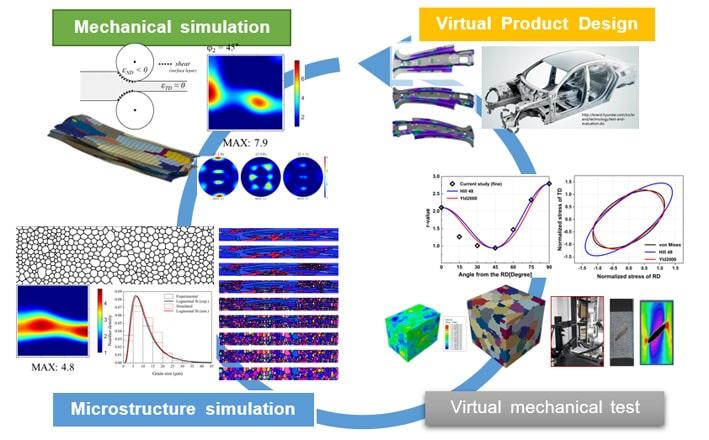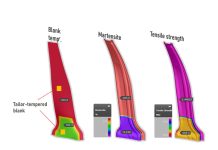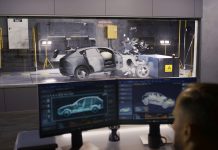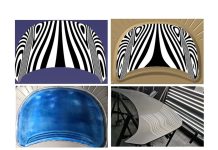Science Talk: Episode 1 – The New Blog Series
In this blog post, we interview Prof. Myoung-Gyu Lee from the Department of Materials Science and Engineering, Seoul National University. Prof. Lee provided valuable insights on the transformation of the sheet metal forming industry in the age of electromobility and discussed the role of forming research in supporting this trend over the next decades. He further commented on his experience preparing to host the first ever virtual International Deep Drawing Research Group (IDDRG) Conference and the lasting impacts of the COVID crisis on the scientific process.
Professor Lee, thank you for joining us. Let’s start by talking about your research direction. You’ve made a number of very valuable contributions to sheet metal forming esearch. Do you have ongoing projects in this field? What do you consider the most pressing challenges?
>>In my research lab at the Seoul National University, we concentrate our efforts on understanding the fundamental mechanical responses of structural materials. Our research highlights integrated multi-physics and multi-scale mechanics based on solid, computational and experimental mechanics to optimize the deformation and mechanical properties of materials. We conduct research and development on materials that consist of metals, polymer and fiber reinforced composites. The application fields include manufacturing of automotive parts and electrical devices, battery components, hybrid joining technology, novel material & process designs. We additionally focus our energy towards experimental techniques for mechanically characterizing highly nonlinear and anisotropic materials in the context of experimental mechanics and constitutive modeling.
To address challenges in the sheet metal forming field, we should aim to understand the impact of microstructure on the properties of material systems while simultaneously developing state of the art computational models and simulations. These will help the field engineers design better-performing materials and processes. To that end, we host ongoing projects with the Hyundai Motor R&D team to develop a virtual integrated simulation process that covers thermo-mechanical-metallurgical processing, microstructure evolutions, and final mechanical properties such as strength, anisotropy and formability.
E-mobility is gaining momentum, while the automotive sector in Korea already has some pioneering applications in this direction. How do you think this will transform the sheet metal industry in the next few decades? How will E-mobility reflect on scientific efforts in this direction?
>> In 2020, the Korean government allocated a 50% increase of investments in electromobility activities in both domestic industries and government sectors compared to 2019, according to public reports from the beginning of this year. The capital was used to purchase eco-friendly electric and hybrid vehicles and additional charging stations in Korea. To give you an idea, about 70% of newly purchased vehicles from public organizations were eco-friendly cars, according to the South Korean Ministry of Trade, Industry and Energy (MOTIE). The Korean government also increased support for electromobility R&D activities by relevant companies, research institutes and universities. The greatest investment into R&D is being directed towards government-oriented activities on the development of hydrogen-powered fuel cell electric vehicles (FCEV). The outcome is still insignificant compared to battery electric vehicles, but the FCEV market will grow rapidly through the support of the Korean government.
The emergence of E-mobility will undoubtedly influence the sheet metal industry into the future. I think the major shift in sheet metal forming technology is increased flexibility in the forming process and materials. In addition, designing lightweight car bodies will still be a core issue in the future of E-mobility. Finally, the importance of understanding the materials used for body design will continue to increase, owing to the faster development of novel materials to accommodate the demand for E-mobility.
As we know, the most distinctive body design change in the electric vehicle is the battery storage, which has various design concepts, depending on the vehicle’s size and specs. In addition, the batteries are typically modular, so any new body structure design should be highly flexible to accommodate various battery storage concepts. This may in turn lead to variable part productions on the same production line, with more flexible press and tool controls to save cost and production time.
The lightweight autobody will be a key design parameter for E-mobility. Moreover, the multi-material strategy of combining different elements such as steel, aluminum and polymeric materials will be critical to composing complicated body structures to accommodate the car battery installation. For passenger safety and protection of the battery itself, high strength steels and aluminum alloys may be used to create major sheet metals for electric vehicles in the near future. Stamping will be the major forming technology, but non-conventional forming methods such as roll forming and incremental forming will be more thoroughly investigated to increase flexibility for the production of complex-shaped sheet metal parts. Various types of joining technology such as conventional welding and other mechanical joining will be adopted into multi-material sheet metal part production.

Fig. 1: Multi-scale modeling for bridging the gap between theory and experiment.
As for scientific efforts towards E-mobility, the increased flexibility in the sheet metal forming parts will diversify the material selection, forming and process parameters. Therefore, a trial-and-error approach to optimizing these aspects will incur higher costs. Simulation technology based on finite element analyses will still be critical to support the automotive industry. The simulations provide not only cost-saving optimizations for forming and joining as done for conventional tool design, but also the digital twin environment for determining the stability of the process as well. The multi-material system employed by E-mobility requires an understanding of each material’s characteristics and its impact on forming and shaping. Simulation must be developed to cover the entire course of processing, microstructure feature, and resultant mechanical properties. Multi-scale, multi-physics-based simulation technology combined with fast-growing big data analyses will be critical research areas in the future of the automotive industry.
You are organizing one of the first virtual conferences in the field of sheet metal forming. What has been your experience as the driving force and the challenges thus far?
>> The original plan was to hold the IDDRG 2020 in Busan in early June 2020. After initially postponing it to the end of October due to COVID-19, we finally decided to hold the first virtual IDDRG conference, with the support of the IDDRG Executive Committee. The primary challenge is attracting more people within the sheet metal forming community to hold a successful virtual conference.
Fortunately, we received valuable advice from the organization of Esaform 2020, who shared their success story of holding a virtual conference in the materials forming field. Of course, we had several other issues raised from the virtual platform, but our organizing team has been working hard to write another success story for the first virtual IDDRG conference. So far, we have received over 180 abstracts, which exceeds our initial expectation. We appreciate the ample interest and support we’ve been given by the global sheet metal forming community.
One of the strongest features of the IDDRG conference has always been its ability to attract contributions/participants from both academia and industry. Do you expect the virtual conference to achieve a similar impact?
The uniqueness of the IDDRG conference lies in the interactions it inspires among the world’s leading experts and researchers from both academia and industry. To remain true to the philosophy of the IDDRG conference, our virtual conference also highlights the importance of balanced participation and contribution from both academia and the sheet metal forming industry. Accordingly, we invited outstanding plenary speakers from both sides. The plenary speakers from academia generally bear their own experience in the industry and work closely with engineers. I expect that the virtual platform will be more efficient for industry workers who can’t easily travel abroad at the best of times. They can participate in the virtual conference even after work hours, without restriction of place. For this reason, we extended the conference period to five days. In IDDRG2020-Virtual, we will provide two tutorial sessions on theoretical and experimental plasticity and metal forming by Prof. Barlat and Prof. Kuwabara, which will be a great asset to student and junior level researchers learning the fundamentals of sheet metal forming.
The virtualization of IDDRG arose out of necessity, but it might have a lasting impact. How do you think the example set by IDDRG 2020 will influence the way sheet metal forming conferences are organized in the future? Do you think that virtual conferences are here to stay after the “COVID era”?
>> The decision to hold the virtual platform of IDDRG this year was indeed inevitable because of the current travel restrictions. It should be said that even before the COVID pandemic, virtual (or online-based) conferences had been steadily increasing by way of live-streamed events. I think the global lockdown has simply accelerated this trend. On the other hand, there are features of physical conferences such as in-person discussions and networking that cannot be easily digitalized. For instance, IDDRG conferences traditionally organize industrial tours, but the virtual conference cannot currently accommodate this experience. A hybrid event may be another option to retain benefits from both modalities.
What about the scientific process in a broader sense. Did you have disruptions in your experimental work due to COVID-19? Do you expect the “COVID” experience to have a significant impact on the way science is produced?
>> I know that most universities in North America and EU countries were on lockdown for a time and researchers were prevented from working in the lab. Fortunately, graduate schools in Korean universities were never locked down, even when the pandemic was at its peak in Korea. As a result, our research programs have always been under control and there have been no severe interruptions in our experimental work. Of course, there were minor inconveniences in preparing test samples that were collected from outside the lab. We had to hold online meetings with the company stakeholders supporting our research projects. This is our experience, but many teams worldwide faced greater challenges. I believe that the scientific process is highly flexible and resilient and will continue to be carried out effectively, despite the difficulties.
About the Author:
Dr. Myoung-Gyu Lee received his PhD from Seoul National University in Korea. He is a Professor of Materials Science and Engineering at Seoul National University. His research interests focus on metal forming, computational plasticity, mechanics of materials including finite element modeling of advanced structure materials, multi-scale modeling and experimentation to reveal deformation mechanisms of materials under complex strain path changes. He has co-authored over 250 journal articles and 2 proceeding volumes, 1 book, and 3 book chapters in the areas of plasticity theory, advanced constitutive modeling, and finite element simulations. He received the 2014 International Journal of Plasticity Award for excellent contribution to the field of plasticity and 2018 POSCO Young researcher award. He chaired the 39th IDDRG conference in October 2020.













